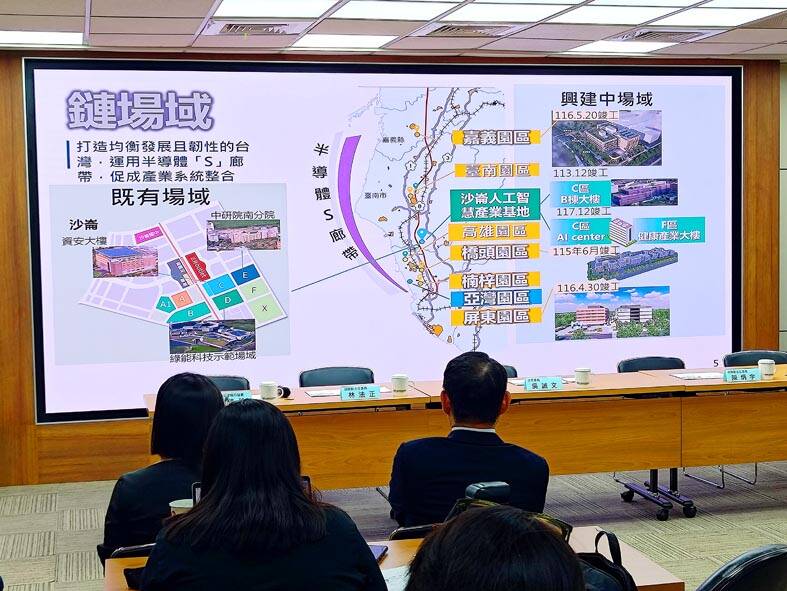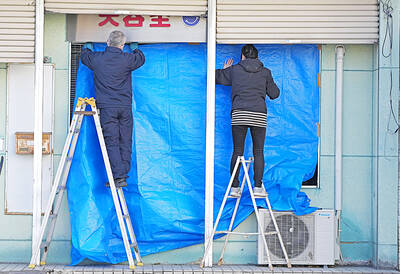The government plans to invest NT$36 billion (US$1.13 billion) over five years to build the foundations for southern Taiwan to become the next big technological center, National Science and Technology Council (NSTC) Minister Wu Cheng-wen (吳誠文) said yesterday.
President William Lai (賴清德), as part of his election campaign platform, proposed to “balance” development in Taiwan and make the nation a bastion of artificial intelligence (AI) technology, the council said.
The ministry’s proposed plan would start from next year to 2029, with NT$12 billion to be invested in increasing computation capacity, NT$17 billion building facilities and sites, and NT$7 billion in attracting talent and developing AI technology applications.

Photo: Wu Po-hsuan, Taipei Times
Wu said he hoped the project would grow relevant industries’ value 10-fold by the time of the project’s conclusion.
Wu emphasized that the government would provide stable power for the project, adding that the Ministry of Economic Affairs would be involved in the decisionmaking process.
NSTC Vice Minister Su Chen-kang (蘇振綱) said the project would focus on Tainan’s Shalun Township (沙崙), which already houses the Executive Yuan’s Cyber Security & Smart Technology Research & Development Building — a test site for innovative technology — Academia Sinica’s southern branch and the Green Energy Technology Demonstration Site.
Shalun would serve as the nation’s development center for the AI industry, and when combined with the S-shaped semiconductor corridor policy, and policies to build up infrastructure in the Chiayi, Ciaotou and Pingtung science parks, it would make southern Taiwan a technological center, he said.
Making southern Taiwan a technological center would help systemically integrate different industries while creating a nation with balanced development, he added.
The project would also encourage 5,400 teachers across 15 vocational schools in southern Taiwan to develop different specialties and help educate 160,000 students, increasing their competitive edge and motivation to work, Su said.
Talent-fostering platforms and centers would attract AI-related workers to Shalun, which would ultimately help feed the talent pool when industries in southern Taiwan digitize, he said.
This would help concentrate talent, information and energy in the south, allowing the region to develop key industries such as information and communications techonology, defense, metal processing, automotive components, clean energy, smart farming, and healthcare and medicine, he said.
An NSTC official commenting on condition of anonymity said that the government’s total computation capacity stands at about 19 petaflops, and the project, alongside the Taiwan Chip-based Industrial Innovation Program, is expected to grow governmental computation capacity to 480 petaflops by 2028.
The S-shaped corridor policy is centered in Kaohsiung’s Nanzih District (楠梓), serving to connect manufacturers in Lujhu (路竹) and Ciaotou (橋頭) districts to the Tainan Science Park and also extends southward to Dashe (大社), Renwu (仁武), Daliao (大寮), Linyuan (林園) and Siaogang (小港) districts, forming a concentration of semiconductor-related industries.

Taiwanese were praised for their composure after a video filmed by Taiwanese tourists capturing the moment a magnitude 7.5 earthquake struck Japan’s Aomori Prefecture went viral on social media. The video shows a hotel room shaking violently amid Monday’s quake, with objects falling to the ground. Two Taiwanese began filming with their mobile phones, while two others held the sides of a TV to prevent it from falling. When the shaking stopped, the pair calmly took down the TV and laid it flat on a tatami mat, the video shows. The video also captured the group talking about the safety of their companions bathing

US climber Alex Honnold is to attempt to scale Taipei 101 without a rope and harness in a live Netflix special on Jan. 24, the streaming platform announced on Wednesday. Accounting for the time difference, the two-hour broadcast of Honnold’s climb, called Skyscraper Live, is to air on Jan. 23 in the US, Netflix said in a statement. Honnold, 40, was the first person ever to free solo climb the 900m El Capitan rock formation in Yosemite National Park — a feat that was recorded and later made into the 2018 documentary film Free Solo. Netflix previewed Skyscraper Live in October, after videos

Starting on Jan. 1, YouBike riders must have insurance to use the service, and a six-month trial of NT$5 coupons under certain conditions would be implemented to balance bike shortages, a joint statement from transportation departments across Taipei, New Taipei City and Taoyuan announced yesterday. The rental bike system operator said that coupons would be offered to riders to rent bikes from full stations, for riders who take out an electric-assisted bike from a full station, and for riders who return a bike to an empty station. All riders with YouBike accounts are automatically eligible for the program, and each membership account

A classified Pentagon-produced, multiyear assessment — the Overmatch brief — highlighted unreported Chinese capabilities to destroy US military assets and identified US supply chain choke points, painting a disturbing picture of waning US military might, a New York Times editorial published on Monday said. US Secretary of Defense Pete Hegseth’s comments in November last year that “we lose every time” in Pentagon-conducted war games pitting the US against China further highlighted the uncertainty about the US’ capability to intervene in the event of a Chinese invasion of Taiwan. “It shows the Pentagon’s overreliance on expensive, vulnerable weapons as adversaries field cheap, technologically